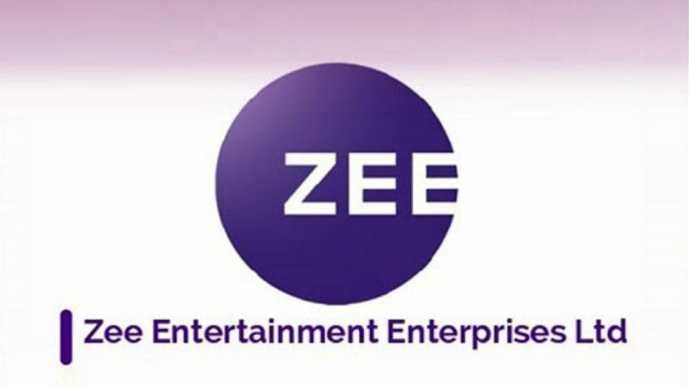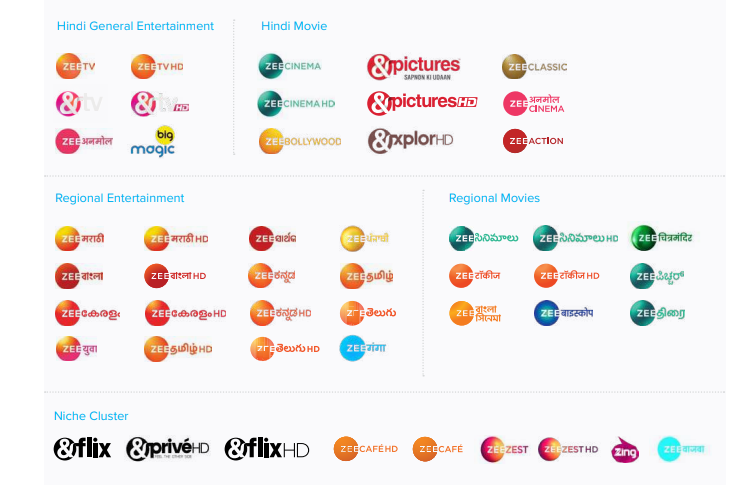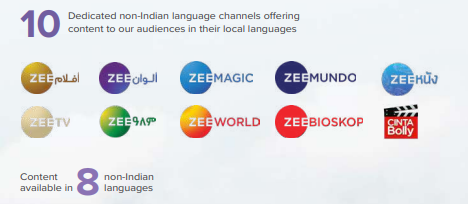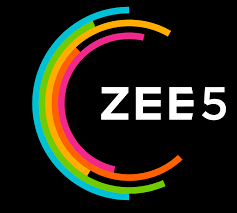Zee Entertainment Enterprises Ltd
Summary
- Zee Entertainment Enterprises Ltd was the India first private satellite TV channel in 1992.
- Zee’s broadcast domestic portfolio of 49 channels caters to the diverse Indian audience across the country.
- ZEEL’s international broadcast portfolio of 35 channels reaches more than 170 countries.

Company Overview
Zee Entertainment Enterprises Ltd (NSE:ZEEL) from giving India its first private satellite TV channel in 1992, to reaching 1.3 billion viewers around the world through linear and digital platforms. ZEE, today, is the global entertainment go-to, with an integrated team creating and serving extraordinary content.1
With a history of almost three-decades of entertaining consumers in India and around the world, ZEEL has crossed several milestones. In this journey, the Company has experienced distinct phases of growth, success, and expansion interspersed with periods of failure and learnings. This journey can be broadly broken into 3 distinct phases – the first phase where ZEE emerged as a brand synonymous to entertainment in India with the world acknowledging its pioneering spirit; the second phase, which began at the start of this century, saw the Company being complacent and playing catch up amidst fierce competition; the third phase lasting till FY20 was the one in which the Company witnessed industry leading growth, expanding its presence across the country and abroad, truly establishing its position as India’s leading entertainment content Company.
In its fourth phase now, termed as ZEE 4.0, the Company has redefined its strategic vision which will help it deliver the next phase of growth. This approach leverages the strong position the Company has established over the years in broadcast segment to help strengthen its position in new businesses. While consumer has always been at the centre of decision making as far as content creation, delivery and monetisation are concerned, the ZEE 4.0 approach will further sharpen this focus. ZEEL has continuously endeavoured to enhance its understanding of consumers to create quality content that engages them. The Company has been on a constant transformation journey, expanding its presence across multiple media verticals to serve a continuously evolving audience base.
Business Overview
Domestic Broadcast Business
Zee’s broadcast portfolio of 49 channels caters to the diverse Indian audience across the country. As India’s widest language footprint network, Zee connects with its consumers with a highquality programming mix of engaging fiction shows, innovative reality show formats, popular movies, and curated licensed content. Zee has continuously expanded its presence, leveraging insights from existing markets and customising it for new language markets. This continuous growth enables Zee to reach more than 600mn people on a weekly basis, making it one of the biggest reach platforms in India today. Along with expansion into new markets, Zee has also broadened its content offering, adding new genres to its portfolio. With daily drama shows, non-fiction shows with celebrity judges and exciting talent, blockbuster movies, music channels, lifestyle content, the network offers a wide range of content for its consumers.2
This expansion across depth and breadth has led to a diversified portfolio which is not dependent on any one language or genre for viewership share. Zee’s success in South markets and movie genre are examples of how the investments Zee has made over a period of time have yielded results. Despite being a late entrant to the South market, the network has grown organically to reach 20% viewership share, becoming a strong player in the region. Zee has become the leader in the movie genre with 25% of the total television movie consumption in India happening on its network. These success stories are reflection of Zee’s long-term growth strategy in action.
- 49 Channels
- 11 Languages
- 600mn+ Weekly reach
- 160bn+ Minutes of weekly time spent

International Broadcast Business
ZEEL’s international broadcast portfolio of 35 channels reaches more than 170 countries, taking Indian content across the globe. The business leverages the content library of the parent network to serve Indian and South Asian diaspora around the world. ZEEL was the first Indian M&E company to start overseas operations and over the years has expanded its linear operations in the Americas, Europe, MENA, APAC and Africa regions. With a mix of channels that carry India feed as well as channels that curate local language content in some markets, it is one of the leading global networks in the world today. While Indian content gets traction from South Asian diaspora, foreign language channels with dubbed content helps taking popular Indian shows and movies to audiences in their native languages.
- America 16 Channels
- Europe 3 Channels
- Mena 5 Channels
- Apac 6 Channels
- Africa 5 Channels

Digital Business
ZEE5, its video-on-demand platform, is one of India’s leading OTT platforms. It leverages the content creation expertise and the content library of all its businesses, offering one of the most exhaustive Indian content catalogues to the digital consumers. ZEE5 is focussed on creating a strong value proposition for Indian consumers and delivering outstanding user experience. ZEE5 offers original content across multiple Indian languages and genres, one of the biggest Indian movie libraries, catch-up and live TV, international content, music videos and much more. It aims to serve the diverse content needs of various audience segments in the country and be the go-to destination for digital audience. The platform has a hybrid revenue model offering exclusive digital original content, premium movies, and much more at an affordable price of ` 499 per year. TV catch-up content, select movie library, music videos are available for free and are monetised through advertising. Zee is also focussed on continually improving user experience through use of technology and product enhancements. ZEE5 also partners extensively with major players in the digital ecosystem to facilitate access to a wider audience base and making it easier for consumers to pay. ZEE5 has been expanding its presence outside India over the past year, and it was recently launched in the US, the largest market for South Asian diaspora.
ZEE5 SVOD
Premium content destination
ZEE5 premium, the SVOD offering of the platform, provides a wide range of digital original shows, blockbuster movies, direct-to-digital movie premieres across multiple Indian languages. The platform has been curated keeping in mind the taste and preferences of the Indian audiences. As the largest publisher of Indian language digital exclusive content, it aims to become the first choice of entertainment for Indian consumers seeking quality content.
- 150+ web series
- 2800+ movies
- Direct-to-digital premieres
ZEE5 AVOD
Anytime, Anywhere Entertainment
ZEE5 offers consumers a vast catalogue of TV shows - 500+ hours of fresh content every week and some of the most popular shows of the past. A 1,000+ movie library means that consumers have plenty of options to choose from. ZEE5 is also a top destination for live news with more than 70+ channels. All this content is available in more than 10 languages, making ZEE5 a pan-India platform.
- 1,000+ shows and movies
- 75 live TV news channels
- 12 language
ZEE5 now available in US
In June this year, ZEE5 was launched in the US, the biggest market for South Asian diaspora. Zee has been present in this market for over two decades, bringing the best of Indian entertainment content through its TV channels. With ZEE5, the company now look to offer audiences access to a much wider choice of TV and digital exclusive content.

Movies & Music
Zee Studios
Zee Studios, the integrated movies vertical of Zee, has emerged as a one-stop destination for production, promotions, advertising & distribution of films across India and the overseas markets. The studio has been focused on films aimed at pairing content with powerful performers and developing concept driven films. It has also established a strong presence in the Marathi, Punjabi, Kannada, Telugu and other regional markets with a string of successful movies over the last few years. The studio leverages the cross-platform strengths and institutional learnings of the parent network which help in achieving better monetisation of its assets.
Zee Studios is an important ally for the broadcast, digital and music businesses, all of which depend on acquisition of various movie rights. The studio aims to scale up its yearly movie output to 35-40 releases across languages and budgets.
During the year, Zee Studios launched ZeePlex, India’s first multi-Platform PPV service, which enables audience to watch some of the latest movies from the comfort of their homes through their DTH connection or on ZEE5. With theatres closed due to the pandemic, the studio released Radhe, one of the biggest movies of the year, on ZeePlex.

Zee Music Company
Zee Music Company (ZMC) is India’s fastest growing music label and the only one with a pan-India reach. It has acquired an expansive catalogue of music rights, across languages, to become the second most ‘listened to’ Indian music label in a short period of time. The label’s catalogue now consists of over 7,500 songs across 11 languages and has an unparalleled reach. With over 75mn subscribers, ZMC is the second most subscribed Indian music channel on YouTube, generating over 4bn video views a month. ZMC’s growth has been driven by its aggressive acquisition strategy with a 50% plus market share in all new Hindi film releases
Live Business
Zee LIVE is ZEEL’s entertainment offering for the consumers in the live events space with a focus on creating IP for music, stand up comic, theatre, culture, food, and education events. It aims to be the gateway to the world for Indian live experiences, while simultaneously bringing the best concepts from around the globe to India. Live events help the Company and its advertising clients reach out directly to the consumers. Zee LIVE has already created 3 properties – Supermoon, Arth and ZEE Educare, and it is experimenting with different formats to establish a competitive position in the live events space, which has significant headroom for growth in India. Zee LIVE plans to create a host of properties targeted at audience of diverse interests and age groups. With restrictions on on-ground live events during the year, Zee LIVE launched virtual live events leveraging network’s digital and satellite footprint.
Industry Overview
The pandemic and the consequent lockdowns impacted the media industry in a peculiar way. It gave a boost to content consumption, on both television and digital platforms, as people were confined to their homes, but it had a negative impact on revenues. The lockdown disrupted consumer demand, especially for discretionary products. The advertisers pulled back on ad spends across mediums. There was also an impact on subscription revenues, though to a lesser degree, helped to some extent by growth in digital revenues. Social distancing norms also had a devastating impact on movie exhibition and live events segments. Accordingly, Media and Entertainment (M&E) sector revenues fell by 24% in CY2020 to Rs 1,383bn. The industry saw a sharp fall in revenues in the first half of the year followed by a ‘V’ shaped recovery, with growth almost reaching pre-pandemic levels by the fourth quarter of the fiscal.
During the year, television’s viewership saw a step jump, driven by both increase in reach and time spent, highlighting the importance of live television in the country. Television segment saw a 13% decline in revenues, primarily driven by 22% fall in ad revenues. The print segment saw a 36% dip in revenues, ceding its number two position in the space to Digital. Consumption of video on digital devices continued to gain traction on the back of rising 4G penetration and increasing content availability across languages. Buoyed by increase in subscription of OTT services, digital media revenues increased by 6% even as digital ad revenues stayed flat. Movies industry bore the maximum brunt of the pandemic as theatrical revenues fell by three fourths due to lockdowns. Several movies skipped theatrical releases and were directly released on digital platforms. The revenues from direct to digital releases were far short of the theatrical revenues and were unable to compensate for the loss. Live events was another segment hit hard due to implementation of social distancing protocols. Organisers took several events directly to digital platforms, however, revenues dropped more than twothirds.
The fall in revenues across segments should not have a lasting impact on the sector’s growth. Even during the pandemic, media consumption remained strong and industry witnessed a sharp rebound in revenue as the number of cases subsided. Structural drivers, such as low per capita entertainment consumption and spends, rising disposable incomes, increasing device penetration and content availability bode well for the long-term growth of the industry. As per the FICCI-EY report on the sector (the Report), Indian M&E industry is poised to grow at a CAGR of 17% over the next 3 years to Rs 2,234bn, with growth expected in each of the segments.
Television
The year gone by was a challenging one for the Indian television industry. It began with the unprecedented 3-month nationwide lockdown, which meant that production of original content was halted across the country, for the first time in the history of the industry. As people were confined to their homes during the lockdown and even after it was lifted, television viewership saw an increase during the year, highlighting the reach and engagement of the platform. However, there was a sharp dip in the advertising revenue in the first half as a result of the economic slowdown which followed the lockdown. While the ad revenue saw a sharp recovery in the second half, lingering fear of resurgence of the pandemic and economic slowdown continued to hold back growth. Television industry revenue declined by 13% to Rs 685bn in CY2020 as per the Report. Advertising and subscription revenue for the industry declined by 21.5% and 7% during the year 2020, respectively. The decline in advertising revenue was mainly driven by the pull back in advertising spends as consumption of discretionary goods and services slowed down as a result of the lockdown. As economic activity resumed with full vigour in the second half of the fiscal, advertising revenues saw a sharp recovery starting the festive period.
However, by the end of the fiscal, a sharp rise in number of COVID-19 cases had again started pulling brakes on the growth engine. Subscription revenue decline was caused by decrease in subscriber numbers due to reverse migration of working population from urban centres to villages and smaller cities. Another factor hindering the growth of subscription revenue was the embargo on any change in channel or bouquet pricing by the broadcasters. As per the Report, India will have 230mn+ TV sets (70% penetration) by 2025, consisting of pay TV, DD FreeDish homes, and internet connected TV sets. Due to its massive reach and high engagement levels, it is expected that television advertising will grow at a CAGR of 11% till CY23 to Rs 345bn, retaining the biggest share of the advertising pie. For the current calendar year, it is expected to grow by 21% on a lower base, largely recovering back to 2019 levels. The second wave of COVID-19 has already affected the growth in the first quarter of the fiscal, although the impact is much lower than last year. While the underlying demand for advertising continues to be robust, driven by India’s secular consumption growth story, economic recovery is key to realising this potential. Volume growth of staple consumer categories, the dominant advertising segment, remains strong with multiple organised players competing for share of voice. In the past, periods of slow advertising growth have been followed by strong growth phase, with companies vying for an increased share in the growing consumption pie. At a $4 ARPU, television subscription revenue continues to be a long-term growth potential, with increasing television penetration, growing adoption of HD channels and the continued reduction in the under declared subscriber base as the accompanying drivers. Over the next 3 years, television industry is expected to grow at a CAGR of 7%.
Financial Highlights
The Company’s consolidated revenues for the year ended 31st March 2021 stood at `77,299 million, compared to Rs 81,299 mn in the previous year, a decline of 4.9%. The revenue for the current financial year includes revenue of Rs 5,512 mn on account of content syndication deal, excluding which revenues for the year declined by 11.7%. This is largely due to degrowth of 19.9% in advertising revenues for the year. Outbreak of COVID-19 at the end of FY20 impacted the advertising revenue severely in the first half of FY21. Domestic advertising revenues for the year ended 31st March 2021 declined by 19.7%. Subscription revenues grew by 12.3% YoY to Rs 32,430 mn (including reclassification of Rs 2,064 million on account of music revenues to subscription). After seeing a strong growth in FY20, domestic subscription revenues grew modestly at 5.8% on a like to like basis to `27,117 mn. Subscription revenues of domestic broadcast business saw a decline in growth as there was a freeze on pricing of channels on account of litigations pertaining to NTO 2.0.
The Company’s operating expenses for the year ended 31st March 2021 (excluding one-offs) declined by 8.6% to Rs 53,856 mn, compared to Rs 58,921 mn in the previous year. Programming related costs declined by 8.2% YoY to Rs 32,775 mn (excluding one-off costs of `4,730 mn in FY21 related to content syndication deal and write-off of Rs 2,598 mn in FY20). The programming cost declined as original programming was stopped in the initial few months of the fiscal due to the nationwide lockdown. Advertising, publicity and other expenses for the year declined by 16.4% YoY to Rs 12,898 mn (excluding one-offs in other expenses of Rs 812 mn in FY21 and Rs 3,433 mn in FY20). EBITDA for the year excluding one offs stood at Rs 17,931 mn, a decline of 19.9% on a normalized basis. The decline in EBITDA is largely due to decline in advertising revenues in the first half of the financial year which was not completely compensated by lower costs. Adjusted EBITDA margins for the year ended 31st March 2021 stood at 25.0%, as compared to 27.5% for the year ended 31st March 2020.
Depreciation and Amortization expense declined by 2.1% YoY to Rs 2,649 mn. During the year, the company reported an exceptional loss of Rs 1,266 mn which includes provision for DSRA guarantee given by Company and impairment of goodwill. During the previous year ended 31st March 2020, the Company had recorded an exceptional loss of Rs 2,843 mn relating to impairment of goodwill in its online media business and provision for inter-corporate deposits (ICDs). Consolidated income tax expense at Rs 4,625 mn witnessed a decline of 7.1% over the previous year. Consolidated profits after taxes including exceptional items stood at Rs 8,001 mn.
As on 31st March 2021, the Company had cash and cash equivalents of Rs 10,907 mn and treasury investments of Rs 7,667 mn. During the year ended 31st March 2021, the Company’s consolidated long-term debt reduced to Rs 195 mn from Rs 3,501 mn during 31st March 2020. Part redemption of preference shares led to the decline in the overall debt position of the Company.
Consolidated cash flow from operations stood at Rs 15,477 mn for the year ended 31st March 2021 as compared to Rs 2,499 mn during the previous year. The increase in cashflow from operations is largely due to release of working capital in the current fiscal whereas there were inflated investments in working capitals during previous financial year.




